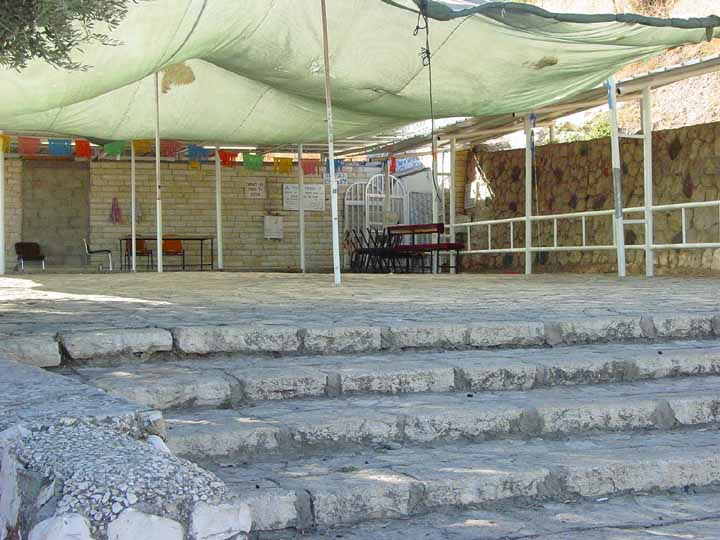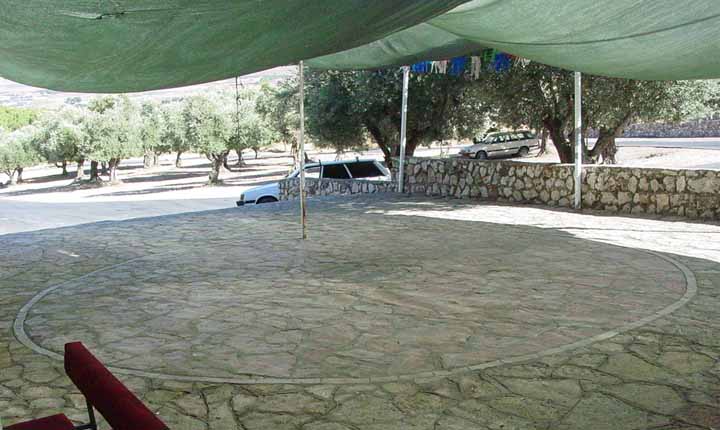CLOSING THE CIRCLE
by Chana Katz
A young schoolboy returning from the gravesite of Choni HaMe’agel breathlessly exclaims: “You know what? I stood in the same circle as Choni!”
To a six-year-old — whose Tsfat class learned the famous story of the Hasmonean-era sage — what could be more exciting than taking a busride to nearby Hatzor and standing in Choni’s circle?
Well, maybe not exactly the same circle Choni drew with a twig more than a thousand years ago. But they say it’s pretty close to the spot where the pious Torah sage actually left his mark.
The child’s enthusiasm is catchy. So let’s visit Hatzor and hear the story again (and stand in the circle too).
To get to the gravesite of Choni by bus from Safed or Tiberias, one must first travel to Hatzor by Egged bus #459, which runs about every 40 minutes from 6 a.m. until 8:30 p.m. From Safed or Kiryat Shmona one can catch bus #511. At the “Canyon” or Hatzor’s central bus depot you can catch the local #2 bus to near the gravesite. The #2 bus runs about every 20 minutes until 9 p.m.
Of course, private transportation along these routes will deliver one right up to the dirt path leading to Choni’s kever. Take the main highway out of Tsfat east toward Rosh Pina, then Route 90 north for another five or ten minutes until you reach the main entrance to Hatzor. Follow the entrance road to the very end until it turns into a dirt road. The signs from there clearly mark the way to the burial site.
 A devastating drought had stricken the land of Israel — a sign, it is said, of a generation burdened by the consequences of not following the Torah. Threatened by famine, the people turned to Choni, whose purity and Torah wisdom left him untainted by the shortcomings of his generation.
A devastating drought had stricken the land of Israel — a sign, it is said, of a generation burdened by the consequences of not following the Torah. Threatened by famine, the people turned to Choni, whose purity and Torah wisdom left him untainted by the shortcomings of his generation.
“Choni,” the people said, “Pray that rain should fall.”
Choni prayed. But nothing happened.
Was he too confident that his prayers would be answered? Did the generation of that day not merit the immediate fulfillment of its plea? That, our sages debate.
But when a child doesn’t get his way he is sometimes very obstinate. And Choni’s relationship with the Creator was a lot like that of a son to a father.
Drawing a circle with a twig, the Mishnah relates, he stepped inside and took an oath not to go out until the people received rain.
It rained…
In very, very little drops — enough to release Choni from his oath. But not enough, said the people, to fill their dried-up wells and avert famine.
So rather than step out, Choni raised his prayer (and his chutzpah) to a higher level: “G-d, this is not what I asked for!”
While the citizens held their breath to await the response, it began to rain. But the drops, our sages say, were as “big as the opening of a jug and no drop less than a log.”
Choni understood that since the time of the exodus from Egypt, the Jewish people still were unable to handle either an abundance or lack of blessings. So with unprecedented chutzpah, he again dared say, “G-d, this is not what I asked for!”
And it rained a normal rain. Except that the rain continued for so long that the people began fleeing to higher elevations. Choni recognized that the people still had not merited truly proper rains, and made an offering on their behalf. And that’s good for Choni, because his daring prayers almost earned him the highest form of exile from the community.
“Were you not Choni I would pronounce a ban upon you,” declared Shimon ben Shetach, the head of the Sanhedrin, the highest legal body of the time. “But what shall I do to you,” Shetach continued, “that you misbehave before G-d and He fulfills your wish — like a son who misbehaves towards his father and his father fulfills his wish.”
From that time on, our sages say, Choni was known as Choni HaMe’Agel (Choni the Circle-Maker).
The circle-story may have been the most famous, but since you’re already at his gravesite in Hatzor, and there are no parking meters to watch out for in this serene mountainside setting, it may be worth your while to hear one more famous story, the Jewish inspiration, one could say, for Rip Van Winkle.
This famous Gemara story (Taanit 23a) about the end of Choni’s life was related by the great Torah teacher R’ Yochanan (although in an earlier version in the Jerusalem Talmud it is written that the story is about our Choni’s grandfather of the same name).
There is a certain psalm (126) which talks about the end of the 70-year Babylonian exile. Despite the bitterness of the exile, the psalm says that when the Jews finally did return to Zion it would be as if they had all been dreamers for the entire time.
Choni wondered how anyone could sleep for 70 consecutive years.
As the saying goes: be careful what you ask for…you just might get it.
Choni met a man planting a carob tree and asked him how long it would take to grow.
“Seventy years,” the man answered.
“Is it clear you will live another 70 years?” Choni asked.
“Just as my ancestors planted those trees for me,” replied the man, “so too I plant for my children.”
With that, Choni sat down to eat and fell into a deep sleep for….70 years.
He did awake, no one recognized him. Not his wife, or children or fellow Torah sages. As a result, Choni was not treated with the honor he had once merited. Soon thereafter he passed away.
You could say that Choni knew that his life had indeed come full circle. Because with his passing he is remembered only for his accomplishments.
That thousands and more visit his gravesite each year, indeed gives Choni the respect for the lessons he taught us all about service to G-d, devotion to Torah and mitzvot and love of his fellow Jew.
Chana Katz, a former South FLorida journalist, lives in Tsfat. Her articles on life in Israel have reached publications throughout the world.
Buy guidebooks to Safed and the Galilee at the Kabbala Online Shop.

